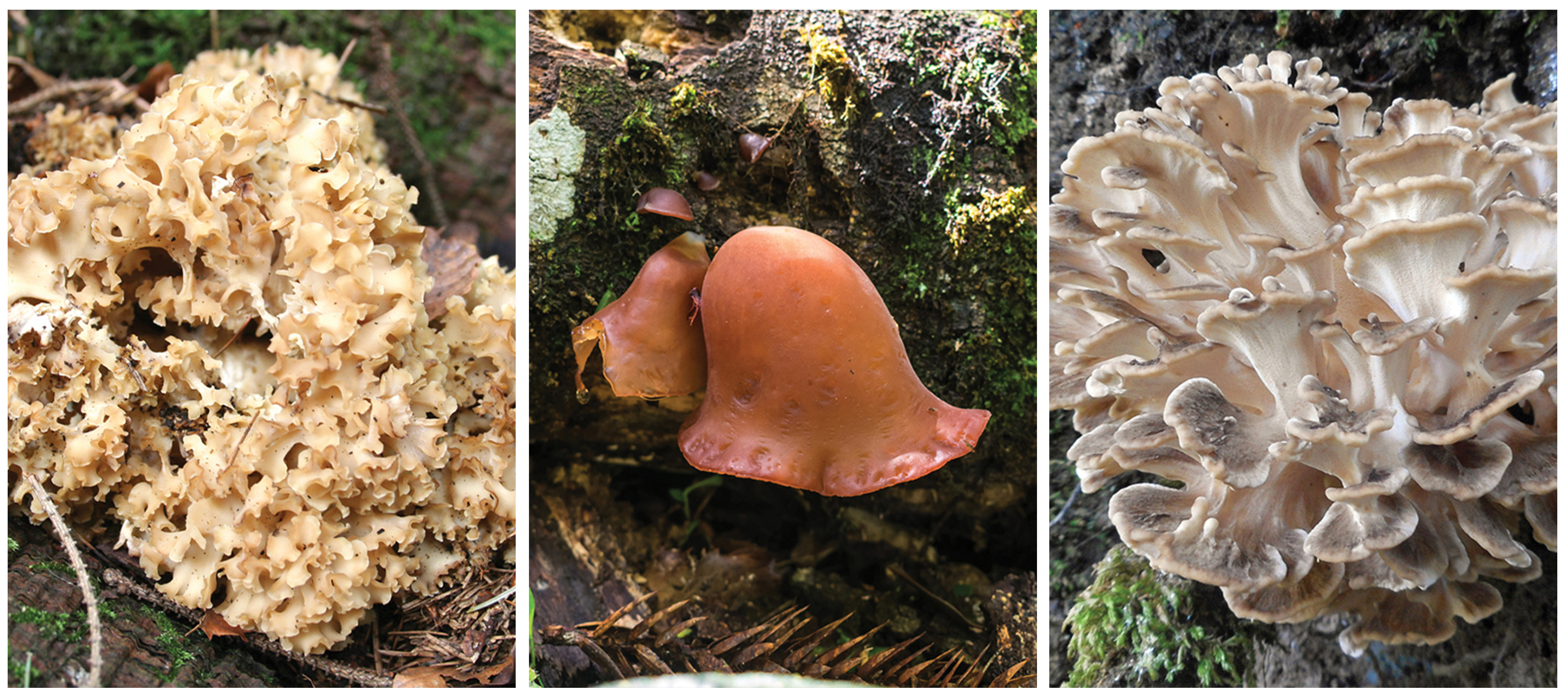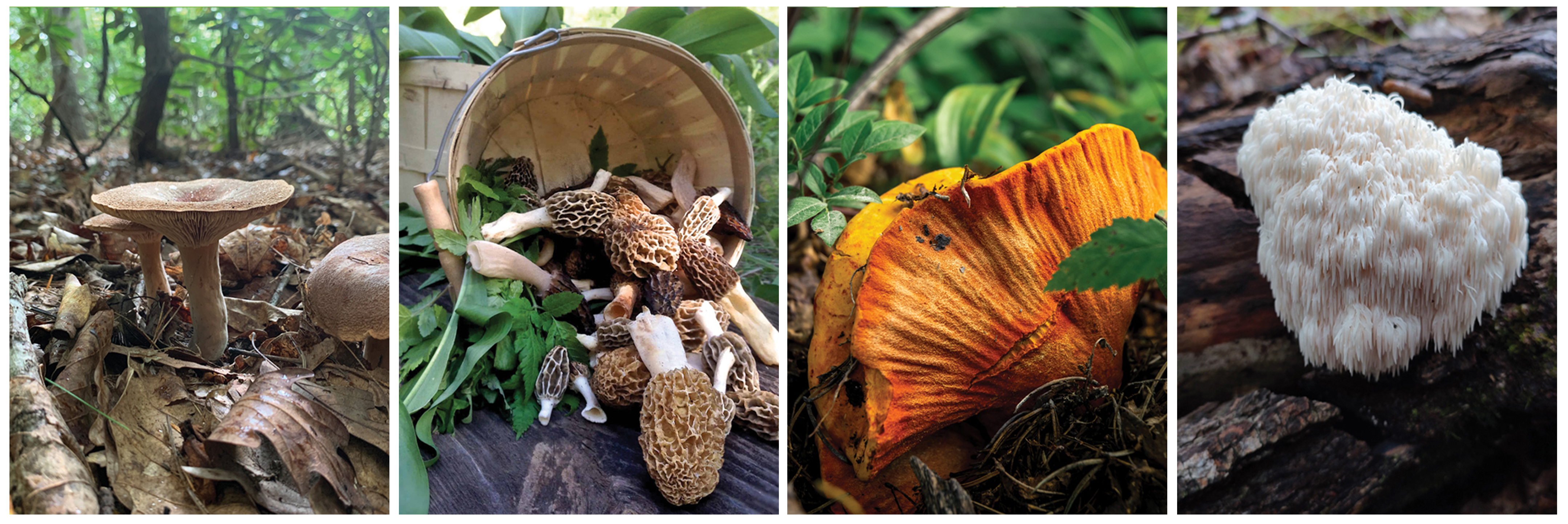In Search of Mushrooms - Happy Hunting
In Search of Mushrooms - Happy Hunting
(Left to right) Chicken of the woods (Laetiporus sulphureus, L. cincinnatus); Chanterelles (Cantharellus spp.) & Black trumpets (Craterellus cinereus)
WARNING -- This list is not exhaustive of all poisonous mushrooms. Do not use this guide as a sole resource when foraging. Always consult an expert on mushrooms.
Now that you’re ignited with interest about the world of fungi, here’s a list of the top 15 varieties to get to know while you wander the woods of Western North Carolina.
Chanterelles (Cantharellus spp.)
Delicious and easy to identify chanterelles come out after rain during really hot weather, during the late summer through early fall. Instead of true gills, these tasty mushrooms have “ridges” on their undersides. Their stems peel like string cheese, they smell a bit like apricots, and they are white inside when cut in half. Lookalikes include inedible scaly vase (Turbinellus floccosus) and poisonous jack-o-lantern (Omphalotus illudens).
Black trumpets (Craterellus cinereus)
Also known as Black Chanterelles, these delicious mushrooms can be well camouflaged in leaf litter. They look like little blackish-grayish funnels and grow in scattered groups; once you find one, it’s likely you’ll find more. They often grow beneath oak trees and can be found from late spring to early fall. Black trumpets’ delicious, earthy flavor gets concentrated when they’re dried.
Chicken of the woods (Laetiporus sulphureus, L. cincinnatus)
A meaty mushroom that tastes like its namesake, this decomposer can grow on rotting logs or living trees. Chicken of the woods often associates with oak, but can also be found on other hardwoods from May through October. Similarly to hen of the woods, this mushroom makes a large mass of overlapping fanline structures, which are either peachy or bright orange on top and cream colored to yellow on the underside. Needs to be well cooked at any age, and is ideal to eat while it’s young and tender.

(Left to right) Turkey tail (Trametes versicolor) & Puffballs (Lycoperdon spp.)
Turkey tail (Trametes versicolor)
As beautiful as their namesake, these mushrooms fan out from fallen branches, logs, stumps, or standing dead trees in small to medium groups. They’re not edible, per-se, because of their dry, leathery texture, but they’re an important medicinal with powerful anti-cancer and immune boosting compounds. Showing stripes of color that range from coppery to silver to blue on their topsides and white with tiny pores underneath, this one is easy to identify, and all lookalikes are harmless.
Puffballs (Lycoperdon spp.)
Round and white, these mushrooms are often found in lawns, meadows, and at the edges of cleared areas from summer through fall. Be careful not to harvest from areas that have been sprayed with chemicals. There are several edible species that all look similar. Puffballs can easily be confused with immature deadly amanita mushrooms. To determine whether you have a harmless puffball or poisonous amanita, slice open the mushroom; it should look uniform inside, like white tofu, rather than revealing the shape of a toadstool.

(Left to right) Cauliflower mushroom (Sparassis americana); Wood ear / Jelly ear (Auricularia fuscosuccinea and other species) & Hen of the woods aka Maitake (Grifola frondosa)
Cauliflower mushroom (Sparassis americana)
Appearing as their namesake suggests, in a mass of off-white to cream colored clusters of ribbon-like branches as the bases of dead or dying pine trees, these tasty mushrooms grow alone, not in groups, and can be quite large, up to ten pounds! They’re best to eat when young and tender, and their season spans from late summer into early fall. Some people call them “egg noodle of the woods” because of their noodle-like texture.
Wood ear/Jelly ear (Auricularia fuscosuccinea and other species)
This mild, rubbery mushroom grows in a wide range of habitats on logs, stumps and branches of hardwood tree species. It’s easy to identify and has no poisonous look-alikes. Wood ear is a traditional ingredient in miso soup and is also a mild blood cleanser.
Hen of the woods aka Maitake (Grifola frondosa)
This delicious edible mushroom is also powerfully medicinal. Hen of the woods grows either at the base of oak trees, or on stumps throughout fall. They can be very large and appear as a mass of brownish or gray fanlike structures with white undersides, overlapping one another. Unlike many other mushrooms, Hen of the Woods has a long shelf-life. Dechiara once found a twenty pound specimen and kept it fresh for over a month in the fridge.

(Left to right) Reishi (Ganoderma tsugae); Painted Bolete & Oyster (Pleurotus ostreatus)
Reishi (Ganoderma tsugae)
Starting in May, you’ll find these shiny reddish-brown paddle, kidney or fan-shaped mushrooms protruding out from dead or dying hemlock trees. When they’re young, the growing edge around the mushroom will be white, and can be cut off and cooked as a tasty food. The rest of the mushroom, and the whole thing later in the season, is too tough to eat and instead is made into medicine as tea, tincture or powder; some folks add reishi to hot chocolate or coffee. Ganoderma lucidum is the species that has been widely studied as a medicine, however it is believed that G. tsugae, which is much more abundant here, has similar healing properties.
Oyster (Pleurotus ostreatus)
These well-known and abundant edible mushrooms grow in large, overlapping clusters on the stumps and logs of a wide array of trees, including tulip poplar, hickories, willows, maples, and magnolia. Oyster mushrooms are very adaptable and can sometimes be found in the dead of winter. Underneath their smooth, white to dull grayish brown, rounded surfaces are knife-like gills. They smell reminiscent of anise or, some say, seafood.
Boletes and their relatives (dotted slippery jack, Suillus granulatus and painted bolete, Suillus pictus) are two of the most common edibles.
With a spongy-looking surface under the cap where gills would usually be found, this group of mushrooms is relatively easy to identify. Narrowing it down to specific varieties, however, can be difficult. Fortunately, none are poisonous, but many don’t taste good and/or are quite slimy. These mushrooms don’t last long once they are picked.

(Left to right) Leatherback (Lactarius corrugis, L. volemus, L. hygrophoroides); Morels (Morchella spp.); Lobster (Hypomyces lactifluorum) & Lion’s mane (Hericium americanum, H. erinaceus, H. coralloides)
Leatherback (Lactarius corrugis, L. volemus, L. hygrophoroides)
This group of classic mushroom-shaped fungi with slightly wrinkled tops and deep, knife-like gills are all edible and tasty. When their flesh is broken they ooze a milky latex. Both the corrugis and volemus develop a fishy smell after they are picked. Leatherbacks are usually found in mixed hardwood forests in the summer and fall.
Lobster (Hypomyces lactifluorum)
This bright orange mushroom grows with conifers in hot summer months, and can often be found partially buried in pine duff. Lobsters parasitize other mushrooms (Russula and Lactarius species), covering them in a thin layer of mycelium that changes their color and distorts their gills. Frequently dirty looking, these vampire mushrooms can smell like ammonia when they’re past their prime. Look for firm, dense mushrooms and leave any that are soft or squishy.
Lion’s mane (Hericium americanum, H. erinaceus, H. coralloides)
A member of a group called “tooth fungi,” lion’s manes look more like big shaggy balls than typical mushrooms. They thrive during cooler weather, typically in the fall or spring, and can be found on hardwoods including oak, beech, and maple. Lion’s mane mushrooms either parasitize or decompose wood, so you’ll see them growing on logs or wounded branches of living trees, sometimes very high up.
Morels (Morchella spp.)
These spring ephemerals are some of the best-tasting and easiest to identify, though they’re not always easy to find. Popping up in the springtime only, they’re often camouflaged in leaf litter. Morels have, “a head-like structure with distinct pits and ridges at the apex of a hollow stalk,” according to Mushrooms of the Southeast. They often grow around tulip poplars, and also with declining elms and ash trees.

(Left to right) Amanita Virosa; Jack-o-Lanterns & Scaly Vase.
WARNING -- Ingesting the wrong mushroom can be deadly. Do not ingest any mushrooms without consulting an expert.
Poisonous Lookalikes
Jack-o-Lanterns
• Like their namesake, jacks present in shades of orange, while chanterelles are usually egg-yellow or white in color.
• When mature, poisonous jack-o-lanterns are typically funnel shaped, but chanterelles are usually not.
• If you see what you think is a chanterelle, but it’s growing from dead wood, stumps, or tree roots, you’re probably looking at a jack-o-lantern. Chanterelles always grow directly from the ground.
• Jacks have gills—thin, paper-like veils for spore dispersal— on their underside, while chanterelles have false gills, which resemble a wrinkly raisin.
• Jack-o-lantern mushrooms often grow in clusters, while chanterelles usually grow on their own.
• Jacks are usually two to three times larger than chanterelles at maturity, and have a thicker, fleshier curved stem.
Scaly Vase
•These mushrooms have a vase, turban or ice cream cone shape with a depression on top. You also won’t notice a discernable separation between the mushroom cap and its stem.
•Their top cap is usually reddish orange or brown, but it’s always darker than the rest of the outer surface of the mushroom, which is typically a pale orange or cream color.
• A scaly vase’s outer surface is covered in folds and wrinkles, and older species tend to develop scales on their caps.
Amanita Virosa
• This mushroom is also known as the Destroying Angel, and is very closely related to the Deathcap, which is responsible for a majority of deaths from mushroom consumption. Do not ingest.
•The Destroying Angel is a medium sized fungus that can reach up to eight inches tall. It’s fully white in color, like the puffball, and when fully matured it’s topped with a cap. It also has a skirt that runs under the top.
• It has mostly-white gills underneath the cap to store its spores.
• Its stalk is off-white, and is larger at the base. It sits in a volva, which is a bulb-like structure.
• Destroying Angels grow in grassy patches near trees, and on the ground in mixed woods.
